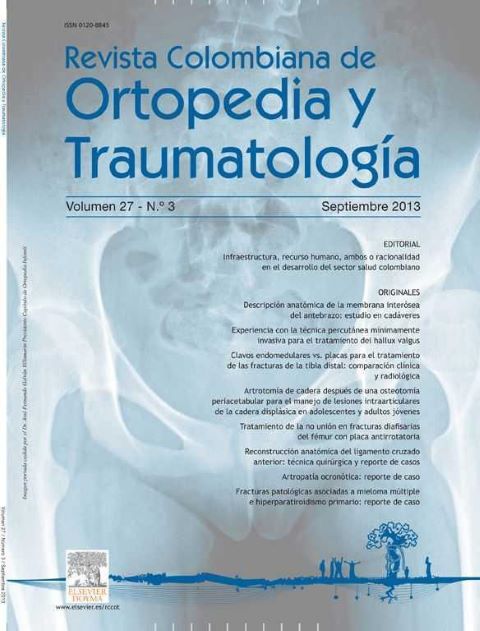Intramedullary nailing vs. plate osteosynthesis for the management of tibial distal fractures: Clinical and radiological comparison
DOI:
https://doi.org/10.1016/S0120-8845(13)70011-7Keywords:
tibial fractures, fracture fixation, intramedullary, bone plates, fracture fixation, internal, evidence level: IVAbstract
Introduction: The surgical treatment of distal fractures of the tibia is controversial, with several studies showing no superiority of one technique over the other. The research objectives were to compare the clinical, radiological and functional results of patients managed with intramedullary nail and plate osteosynthesis for distal tibial fractures.
Materials and methods: A quasi-experimental study was conducted on 25 patients with distal tibial fractures that occurred between April 2009 and March 2011. A record was made of presence of clinical and radiological consolidation of fractures, in addition to the application of the functional scale (IOWA). The duration of surgery, hospital stay, time between admission and definitive surgery was also recorded.
Results: All fractures healed at similar follow-up times. There was no difference in the clinical and radiological consolidation between osteosynthesis groups. Functional results were excellent in both groups. Although not statistically significant, the duration of surgery, hospital stay and the time between hospital admissions until the final assessment favored the intramedullary nail.
Discussion: Consolidating clinical, radiological and functional outcomes were similar between groups. The superiority of one method over another cannot be concluded, but it is suggested that the choice should be made based on experience and preference of the surgeon.
Downloads
References
Bedi A, Le TT, Karunakar MA. Surgical treatment of nonarticular distal tibia fractures. J Am Acad Orthop Surg. 2006;14:406-16. https://doi.org/10.5435/00124635-200607000-00003
Fisher WD, Hamblen DL. Problems and pitfalls of compression fixat ion of long bone fract ures: a review of result s and complications. Injury. 1978;10:99-107. https://doi.org/10.1016/S0020-1383(79)80069-8
McFerran MA, Smith SW, Boulas HJ, Schwartz HS. Complications encountered in the treatment of pilon fractures. J Orthop Trauma.1992;6:195-200. https://doi.org/10.1097/00005131-199206000-00011
Olerud S, Karlst röm G. Tibial fract ures t reat ed by AO compression osteosynt hesis: experiences from a five year material. Acta Orthop Scand Suppl. 1972;140:1-104. https://doi.org/10.3109/ort.1972.43.suppl-140.01
Rüedi T. Fractures of the lower end of the tibia into the ankle joint: results 9 years after open reduction and internal fixation. Injury.1973;5:130-4. https://doi.org/10.1016/S0020-1383(73)80089-0
Collinge C, Sanders R, DiPasquale T. Treatment of complex tibial periarticular fractures using percutaneous techniques. Clin Orthop Relat Res. 2000:69-77.
Francois J, Vandeputte G, Verheyden F, Nelen G. Percutaneous plate fixation of fractures of the distal tibia. Acta Orthop Belg. 2004;70:148-54.
Bahari S, Lenehan B, Khan H, McElwain JP. Minimally invasive percut aneous plate fixat ion of dist al t ibia fractures. Act a Orthop Belg. 2007;73:635-40.
Hazarika S, Chakravart hy J, Cooper J. Minimally invasive locking plat e ost eosynt hesis for fract ures of t he dist al tibia-results in 20 patients. Injury. 2006;37:877-87. https://doi.org/10.1016/j.injury.2006.06.002
Collinge C, Prot zman R. Outcomes of minimally invasive plate osteosynthesis for metaphyseal distal tibia fractures. J Orthop Trauma. 2010;24:24-9. https://doi.org/10.1097/BOT.0b013e3181ac3426
Collinge C, Kuper M, Larson K, Prot zman R. Minimally invasive plat ing of high-energy met aphyseal dist al t ibia fract ures. J Orthop Trauma. 2007;21:355-61. https://doi.org/10.1097/BOT.0b013e3180ca83c7
Ehlinger M, Adam P, Bonnomet F. Minimally invasive locking screw plate fixation of non-articular proximal and distal tibia fractures. Orthop Traumatol Surg Res. 2010;96:800-9. https://doi.org/10.1016/j.otsr.2010.03.025
Gupta RK, Rohilla RK, Sangwan K, Singh V, Walia S. Locking plate fixation in distal metaphyseal tibial fractures: series of 79 patients. Int Orthop. 2010;34:1285-90. https://doi.org/10.1007/s00264-009-0880-4
Ronga M, Longo UG, Maffulli N. Minimally invasive locked plat ing of dist al t ibia fract ures is safe and effect ive. Clin Orthop Relat Res. 2010;468:975-82. https://doi.org/10.1007/s11999-009-0991-7
Hasenboehler E, Rikli D, Babst R. Locking compression plate wit h minimally invasive plate osteosynt hesis in diaphyseal and distal tibial fracture: a retrospective study of 32 patients. Injury. 2007;38:365-70. https://doi.org/10.1016/j.injury.2006.10.024
Krackhardt T, Dilger J, Flesch I, Hönt zsch D, Eingart ner C, Weise K. Fract ures of t he dist al t ibia t reated wit h closed reduction and minimally invasive plating. Arch Orthop Trauma Surg. 2005;125:87-94. https://doi.org/10.1007/s00402-004-0778-y
Redfern DJ, Syed SU, Davies SJ. Fractures of the distal tibia: minimally invasive plate osteosynthesis. Injury. 2004;35:615-20. https://doi.org/10.1016/j.injury.2003.09.005
Helfet DL, Shonnard PY, Levine D, Borrelli J Jr. Minimally invasive plate osteosynthesis of distal fractures of the tibia. Injury. 1997;28 Suppl 1:A42-7. https://doi.org/10.1016/S0020-1383(97)90114-5
Blachut PA, O'Brien PJ, Meek RN, Broekhuyse HM. Interlocking int ramedullary nailing wit h and wit hout reaming for t he treatment of closed fractures of the tibial shaft. A prospective, randomized study. J Bone Joint Surg Am. 1997;79:640-6. https://doi.org/10.2106/00004623-199705000-00002
Finkemeier CG, Schmidt AH, Kyle RF, Templeman DC, Varecka TF. A prospective, randomized study of intramedullary nails inserted with and without reaming for the treatment of open and closed fractures of the tibial shaft. J Orthop Trauma. 2000;14:187-93. https://doi.org/10.1097/00005131-200003000-00007
Keating JF, O'Brien PJ, Blachut PA, Meek RN, Broekhuyse HM. Locking intramedullary nailing with and without reaming for open fractures of the tibial shaft. A prospective, randomized study. J Bone Joint Surg Am. 1997;79:334-41. https://doi.org/10.2106/00004623-199703000-00003
Fan CY, Chiang CC, Chuang TY, Chiu FY, Chen TH. Interlocking nails for displaced metaphyseal fractures of the distal tibia. Injury. 2005;36:669-74. https://doi.org/10.1016/j.injury.2004.10.018
Nork SE, Schwart z AK, Agel J, Holt SK, Schrick JL, Winquist RA. Intramedullary nailing of distal metaphyseal tibial fractures. J Bone Joint Surg Am. 2005;87:1213-21. https://doi.org/10.2106/00004623-200506000-00005
Dogra AS, Ruiz AL, Thompson NS, Nolan PC. Dia-metaphyseal distal tibial fractures-treatment with a shortened intramedullary nail: a review of 15 cases. Injury. 2000;31:799-804. https://doi.org/10.1016/S0020-1383(00)00129-7
Tyllianakis M, Megas P, Giannikas D, Lambiris E. Interlocking intramedullary nailing in distal tibial fractures. Orthopedics. 2000;23:805-8. https://doi.org/10.3928/0147-7447-20000801-13
Mohammed A, Saravanan R, Zammit J, King R. Intramedullary t ibial nailing in dist al t hird t ibial fractures: dist al locking screws and fracture non-union. Int Orthop. 2008;32:547-9. https://doi.org/10.1007/s00264-007-0356-3
Megas P, Zouboulis P, Papadopoulos AX, Karageorgos A, Lambiris E. Distal tibial fractures and non-unions treated with shortened intramedullary nail. Int Orthop. 2003;27:348-51. https://doi.org/10.1007/s00264-003-0499-9
Obremskey WT, Medina M. Comparison of int ramedullary nailing of distal third tibial shaft fractures: before and after traumatologists. Orthopedics. 2004;27:1180-4. https://doi.org/10.3928/0147-7447-20041101-15
Russell GV Jr, Pearsall AW 4t h. Int ramedullary nailing of distal tibial fractures: a technique to prevent malalignment. Orthopedics. 2003;26:183-5. https://doi.org/10.3928/0147-7447-20030201-23
Im GI, Tae SK. Dist al met aphyseal fract ures of t ibia: a prospect ive randomized t rial of closed reduct ion and int ramedullary nail versus open reduct ion and plat e and screws fixation. J Trauma. 2005;59:1219-23. https://doi.org/10.1097/01.ta.0000188936.79798.4e
Yang SW, Tzeng HM, Chou YJ, Teng HP, Liu HH, Wong CY. Treatment of distal tibial metaphyseal fractures: Plating versus shortened intramedullary nailing. Injury. 2006;37:531-5. https://doi.org/10.1016/j.injury.2005.09.013
Hoenig M, Gao F, Kinder J, Zhang LQ, Collinge C, Merk BR. Extra-articular distal tibia fractures: a mechanical evaluation of 4 different treatment methods. J Orthop Trauma. 2010;24:30-5. https://doi.org/10.1097/BOT.0b013e3181c29bc0
Janssen KW, Biert J, van Kampen A. Treatment of distal tibial fractures: plate versus nail: a retrospective outcome analysis of matched pairs of patients. Int Orthop. 2007;31:709-14. https://doi.org/10.1007/s00264-006-0237-1
Guo JJ, Tang N, Yang HL, Tang TS. A prospective, randomised t r ial compar ing closed int r amedull ar y nailing wit h percutaneous plating in the treatment of distal metaphyseal fractures of the tibia. J Bone Joint Surg Br. 2010;92:984-8. https://doi.org/10.1302/0301-620X.92B7.22959
Zelle BA, Bhandari M, Espiritu M, Koval KJ, Zlowodzki M. Treatment of distal tibia fractures without articular involvement: a systematic review of 1125 fractures. J Orthop Trauma. 2006;20:76-9. https://doi.org/10.1097/01.bot.0000202997.45274.a1
Merchant TC, Dietz FR. Long-term follow-up after fractures of the tibial and fibular shafts. J Bone Joint Surg Am. 1989;71:599-606. https://doi.org/10.2106/00004623-198971040-00016
Downloads
Published
How to Cite
Issue
Section
License
Copyright (c) 2024 Revista Colombiana de ortopedia y traumatología

This work is licensed under a Creative Commons Attribution 3.0 Unported License.




